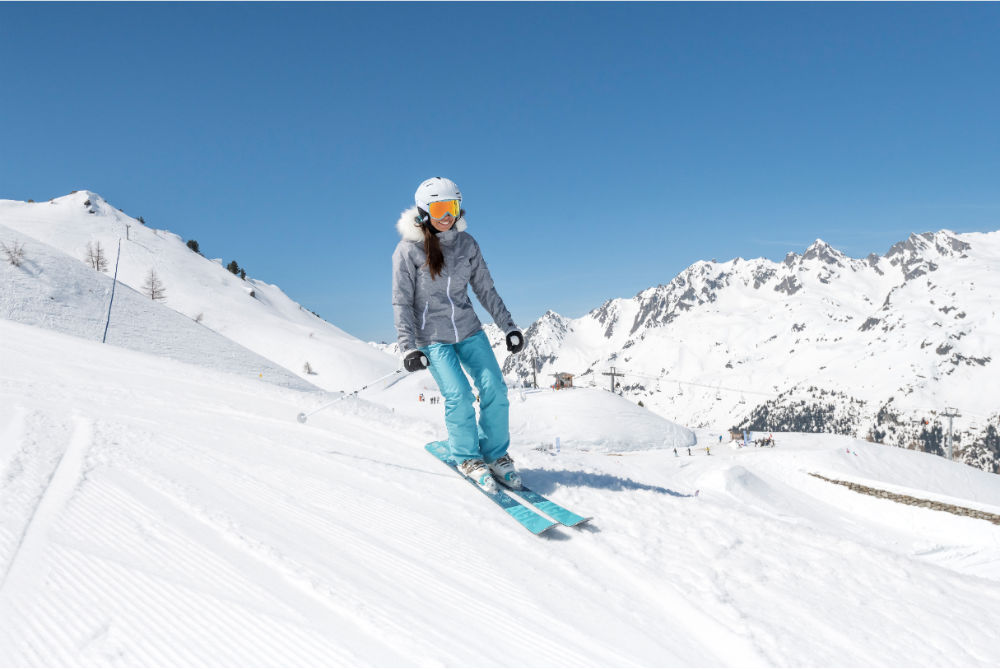
The ski season is well underway, and experts and beginners alike are hitting slopes across the world, enjoying all the excitement the sport has to offer.
There’s plenty to think about before you hit the slopes, so we caught up with Tea Djumisic, ski expert at multi-sports retailer Decathlon, who has been skiing for more than 27 years, to find out her top tips for beginners.
1. Your equipment: Get the essentials!
If you’re just starting out, knowing which equipment you’ll need can be a bit of a minefield. You may hear ski equipment referred to as hardware and software. Hardware includes items like skis, boots and helmets (the hard stuff!), while software refers to things like gloves, socks, fleeces, pants and ski jackets (the soft stuff!).
The first things you’ll want to tick off the list will be a helmet and goggles, closely followed by a good pair of ski boots. Once you have these, I’d focus on finding the right skis and ski poles for you.
If you visit a specialist sports store, they should have experts who can help you choose the right equipment for you and sort the essentials from the ‘nice-to-haves’.
2. Safety first
As fun as it is, skiing can be a dangerous sport if the right care isn’t taken, so there’s a few important things to remember to help keep you stay safe on the slopes.
- First and foremost, be attentive at all times. The skier in front of you always has priority, and avoid cordoned-off areas which are that way for a reason.
- Once you get the confidence to increase your speed, overtaking is allowed, but you must leave enough room in case the skier you’re passing changes direction.
- Never stop on the ski run, unless there’s an emergency.
- Invest in equipment designed to keep you safe. Helmets are an absolute must, but you can also buy extra safety gear including back, bum, wrist and knee protectors which are all very worthwhile investments.
The International Ski Federation has developed ‘Rules of Conduct’, essentially a ‘Highway Code’ for the snow, which is a must read for all skiers.
3. Check your travel insurance
Travel insurance is an essential for all holidays, but remember that a standard policy will not cover you for skiing – or any winter sports for that matter – so make sure you get winter sports cover before you set off. It’s also important to check you’re covered for things like on-piste rescue, loss or damage to ski equipment and any other third-party costs you may face if you have an accident on the slopes.
The gov.uk website has produced a booklet for British skiers which gives detailed advice about travel insurance, including a downloadable #skisafe checklist.
4. Invest in some lessons
Ski lessons are a must, either before you head off on your holiday, or once you get to the resort. Depending on your budget, you can either sign up to a ski school or consider private tuition. This option may cost more, but it means you have the undivided attention of your instructor, which can help you find your feet (or skis!) more quickly.
On the other hand, group ski school sessions can be great fun and you have the benefit of learning with other beginners too. If you’re heading out to a resort, you can check to see if they have a British ski school, such as BASS in France or the Austria-based Skivolution.
5. Focus on your fitness
Learning to ski requires determination, but you also need to be physically fit. Your leg muscles need to be strong enough for manoeuvres like the snowplough (pushing the back of your skis outwards for better stability and control of speed). It’s among the first techniques beginners are taught and a good level of fitness will make it easier to master – and more enjoyable.
There are plenty of ways you can get fit before a skiing holiday. Consider taking the stairs instead of the lift. Think about cycling or walking to work instead of taking public transport or driving, and consider muscle-building exercises like lunges, squats and leg extensions to help build up your leg strength. Check out this article for some more detailed tips on how to train for the slopes.
6. Fallen down? Get back up again!
The occasional fall is inevitable, so when you do, don’t be disheartened.
Your lessons should teach you how to fall as safely as possible. If you do have control over your fall, try to land sideways, with your skis straight ahead.
The hardest part about falling is getting up again. Take a deep breath and then bend your knees, bringing them close to your chest (so they are facing downhill). Next, push yourself up onto your feet so you’re in a squat position (you can use your poles to help you) and then slowly stand up.
You can find more skiing tips and advice on the Decathlon website here.
Tagged in winter

